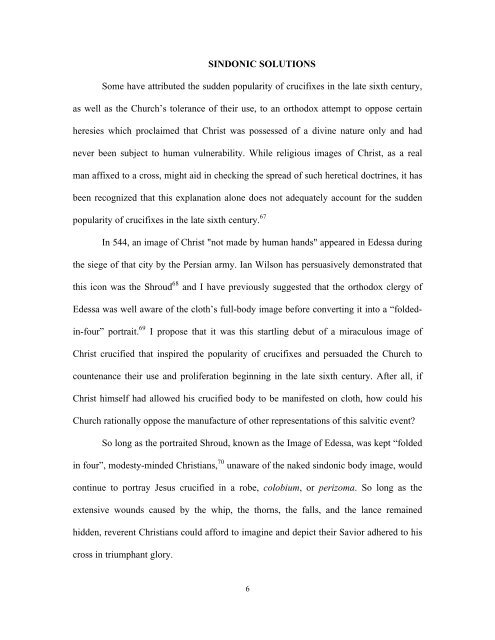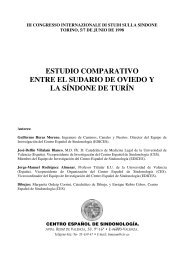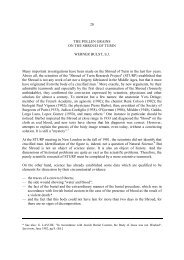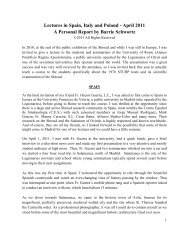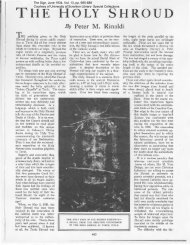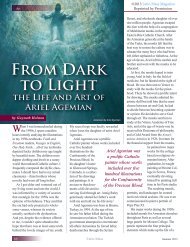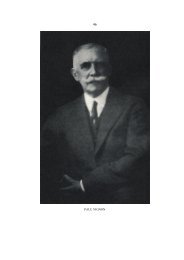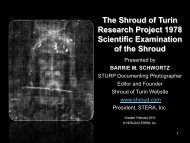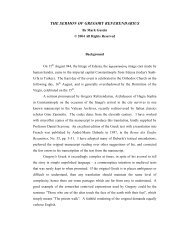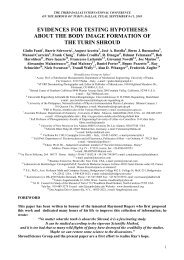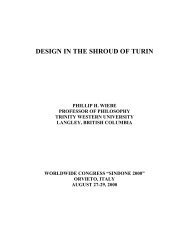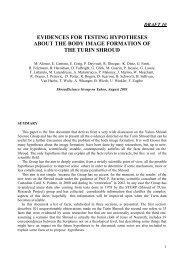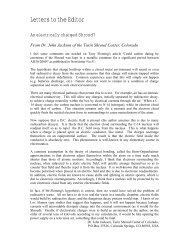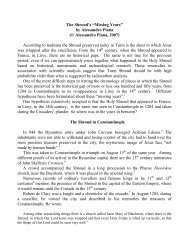the cathar crucifix - The Shroud of Turin
the cathar crucifix - The Shroud of Turin
the cathar crucifix - The Shroud of Turin
You also want an ePaper? Increase the reach of your titles
YUMPU automatically turns print PDFs into web optimized ePapers that Google loves.
SINDONIC SOLUTIONS<br />
Some have attributed <strong>the</strong> sudden popularity <strong>of</strong> <strong>crucifix</strong>es in <strong>the</strong> late sixth century,<br />
as well as <strong>the</strong> Church’s tolerance <strong>of</strong> <strong>the</strong>ir use, to an orthodox attempt to oppose certain<br />
heresies which proclaimed that Christ was possessed <strong>of</strong> a divine nature only and had<br />
never been subject to human vulnerability. While religious images <strong>of</strong> Christ, as a real<br />
man affixed to a cross, might aid in checking <strong>the</strong> spread <strong>of</strong> such heretical doctrines, it has<br />
been recognized that this explanation alone does not adequately account for <strong>the</strong> sudden<br />
popularity <strong>of</strong> <strong>crucifix</strong>es in <strong>the</strong> late sixth century. 67<br />
In 544, an image <strong>of</strong> Christ "not made by human hands" appeared in Edessa during<br />
<strong>the</strong> siege <strong>of</strong> that city by <strong>the</strong> Persian army. Ian Wilson has persuasively demonstrated that<br />
this icon was <strong>the</strong> <strong>Shroud</strong> 68 and I have previously suggested that <strong>the</strong> orthodox clergy <strong>of</strong><br />
Edessa was well aware <strong>of</strong> <strong>the</strong> cloth’s full-body image before converting it into a “folded-<br />
in-four” portrait. 69 I propose that it was this startling debut <strong>of</strong> a miraculous image <strong>of</strong><br />
Christ crucified that inspired <strong>the</strong> popularity <strong>of</strong> <strong>crucifix</strong>es and persuaded <strong>the</strong> Church to<br />
countenance <strong>the</strong>ir use and proliferation beginning in <strong>the</strong> late sixth century. After all, if<br />
Christ himself had allowed his crucified body to be manifested on cloth, how could his<br />
Church rationally oppose <strong>the</strong> manufacture <strong>of</strong> o<strong>the</strong>r representations <strong>of</strong> this salvitic event?<br />
So long as <strong>the</strong> portraited <strong>Shroud</strong>, known as <strong>the</strong> Image <strong>of</strong> Edessa, was kept “folded<br />
in four”, modesty-minded Christians, 70 unaware <strong>of</strong> <strong>the</strong> naked sindonic body image, would<br />
continue to portray Jesus crucified in a robe, colobium, or perizoma. So long as <strong>the</strong><br />
extensive wounds caused by <strong>the</strong> whip, <strong>the</strong> thorns, <strong>the</strong> falls, and <strong>the</strong> lance remained<br />
hidden, reverent Christians could afford to imagine and depict <strong>the</strong>ir Savior adhered to his<br />
cross in triumphant glory.<br />
6


